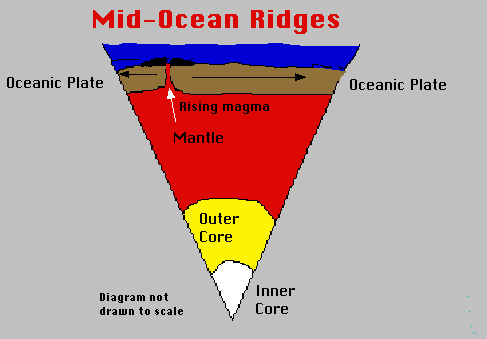
Geologists came to the conclusion in the 1960's that the Earth's rigid outer layer (crust and outer, rigid layer of the mantle) was not a single piece, but was broken up into about 12 large pieces called plates. The red lines on the map of the world above indicate
1. Convergent boundaries - two plates collide to form mountains or a subduction zone.
2. Divergent boundary - two plates are moving in opposite directions as in a mid-ocean ridge.
3. Transform boundary - two plates are sliding past each other as in the San Andreas fault of California. A transform boundary is like a tear in the Earth's crust. These plates move very slowly across the surface of the Earth as though they were on a conveyor belt. The convection currents in the much hotter mantle continually move the plates about 1/2 to 4 inches per year.
When the plates move they collide or spread apart allowing the very hot molten material called lava to escape from the mantle. When collisions occur they produce mountains, deep underwater valleys called trenches, and volcanoes. As mountains and valleys are being formed natural disasters such as earthquakes and volcanic activity can occur which has affected humans for thousands of years.

The Earth is producing "new" crust where two plates are diverging or spreading apart. This occurs in the middle of our great oceans. The mid-ocean ridges are the longest continually running mountain range in the world. These ridges are connected and are about 40,000 miles long!!
One of these mid-ocean ridges, the Mid-Atlantic ridge , is spreading apart making the Atlantic Ocean wider. As the two plates move the mantle melts, making magma and lava fill the void with newly formed rock. The bottom of the Atlantic Ocean is filled with some of the "youngest" crust on Earth. The island of Iceland, located in the North Atlantic, is still being formed at this Mid-Atlantic ridge.
The Atlantic Ocean is getting larger as the Western Hemisphere moves away from Europe and Asia. The Pacific Ocean, on the other hand, is becoming smaller and smaller. This is occurring because the North American and South American plates are moving westward toward Asia and Australia.

The North and South American plates are crashing into the thinner and denser oceanic plates of the Pacific. This drives the oceanic plates deep into the mantle destroying the oceanic plates. This boundary in which an oceanic plate is driven down and destroyed by a continental plate is called a subduction zone.
This Pacific Ocean region has more earthquakes and volcanic activity than any other area of the world. Because of all the volcanoes this region has been given the nickname of "The Ring of Fire" .

When the less dense, lighter continental plate overrides the oceanic plate a subduction zone forms. Because the oceanic plate is bent and driven down, a deep trench forms at this collison point. These trenches are the lowest points on the Earth's crust. One trench is a mile deeper than Mount Everest is tall!
As the oceanic plate descends into the mantle some of it melts. This material moves into the mantle above the plate and causes the mantle to melt. This liquid rock, called magma, rises to the surface because it is less dense then the surrounding rock. If the magma reaches the surface of the Earth, a volcano forms.

As the mantle rocks melt they form magma. The magma collects in a magma pool. Because the magma is less dense than the surrounding mantle material it will rise. Pressure in the magma cracks the overlying rocks. Then the magma injects into the crack. This process repeats thousands of times, bring the magma towards the surface.

A volcano will form if the magma reaches the surface. When magma does reach the surface it is then called lava.
You will learn more about volcanoes in the following lessons.

As the volcano erupts it may build a mountain. The lava along with ash and other pyroclastic material will continue to build the mountain higher with each eruption.
The Cascade mountain range in the Western United States and the Andes Mountains in South America were formed in this way!!

This is a cross section of the Earth in the Southern Hemisphere. The map shows a subduction zone that has created the Peru-Chile Trench at the western edge of South America. This subduction zone has produced the Andes Mountains which run along the entire west coast of South America. It also shows you the Mid-Atlantic Ridge which is spreading the Atlantic Ocean making it wider and wider. The cross section shows two processes at work;
1. "Old Crust" being destroyed at a subduction zone and
2. "New Crust" being produced at the Mid-Atlantic Ridge.

The pink lines on this map of the Pacific Ocean represent deep ocean trenches. These trenches are some of the lowest points on the crust of the Earth. Marianas Trench north of New Guinea is the deepest point on the Earth's surface at 36,201 feet below sea level. Marianas Trench is 7,173 feet deeper than Mount Everest is high!!!!
Trenches surround almost all of the Pacific Ocean. Some of the other trenches of the Pacific are the Aleutian, Peru-Chile, Kuril, and the Japan trench.
There are trenches wherever continental plates and oceanic plates collide. The Java Trench in the Indian Ocean is the deepest point of that ocean at 24,442 feet below sea level.
Write the answers to the following questions in complete sentences on a piece of paper. Use the page titles located directly under the questions to move your way through the lesson to locate the answers. When you finish the questions click on the Earth icon to return the program to the beginning.
1. In your own words explain what happens at a subduction zone.
2. In your own words explain what happens at a mid-ocean ridge.
3. At a subduction zone what causes magma to rise?